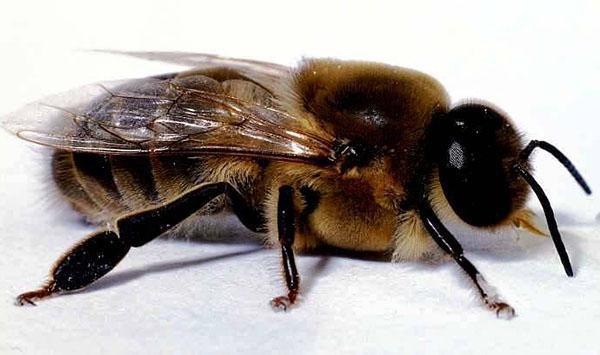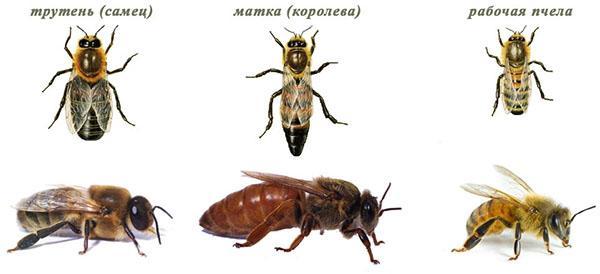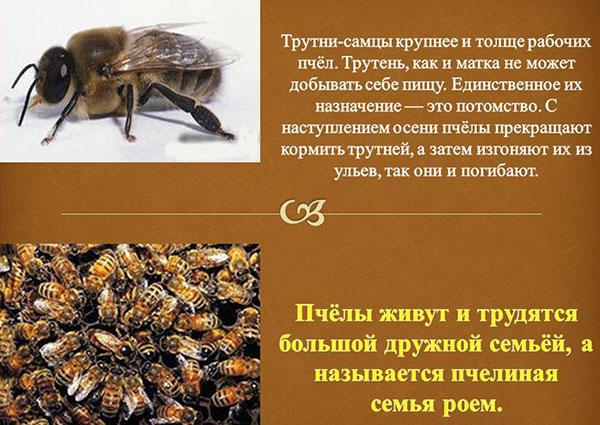What are drones in a bee colony for?
 For people who do not understand at all in beekeeping, it is difficult to understand what duty the drones perform in the bee family and why they are needed in the hive. Many people know the erroneous judgment: the drone does not benefit the hive, but only eats for three. But be that as it may, nature has provided for the presence of males in each nest. So why do we need drones in the hive? What role do they play in the bee family?
For people who do not understand at all in beekeeping, it is difficult to understand what duty the drones perform in the bee family and why they are needed in the hive. Many people know the erroneous judgment: the drone does not benefit the hive, but only eats for three. But be that as it may, nature has provided for the presence of males in each nest. So why do we need drones in the hive? What role do they play in the bee family?
Description of appearance

The drone's task is to fertilize the queen of the hive. The appearance of the insect differs significantly from the queen and from other bees. The drone is much larger than an ordinary working bee, the insect reaches 18 mm in length and can weigh up to 270 mg.
The drone has well-developed large eyes and wings that are huge by bee standards. The life of an insect is very envy of the hive, because it has a small proboscis and cannot feed on its own. Also, unlike other bees, it does not have brushes and combs, which are needed to collect and transport pollen. The male does not have glands that produce wax and royal milk. He also lacks a sting, so that the male is completely defenseless against other insects.
The male has the best developed those parts of the body that are necessary for him to perform his main task, namely the fertilization of females.
Excellent eyesight, long flight duration and charm are the main qualities of the drone, helping him to do his job.
What is the role of drones in a bee colony?
 The role of this insect is to carry genetic material in its seed and pass it on. After all, the drone is the only one in the whole hive who is able to fertilize the queen. When the first drones appear in spring, the bee family actively feeds and takes care of them.
The role of this insect is to carry genetic material in its seed and pass it on. After all, the drone is the only one in the whole hive who is able to fertilize the queen. When the first drones appear in spring, the bee family actively feeds and takes care of them.
The male drone is ready to perform its duties after 14 days from the date of hatching. Fertilization of the uterus does not occur in the nest, but outside its borders and right on the fly. That is why nature has awarded the drone with big eyes and wide wings. The drone usually goes to search for female queens in the middle of the day and can make up to three flights in one day. A male can stay in flight for up to half an hour, which is significantly more than an ordinary bee can.
At the moment when the female is found and overtaken, the drone begins mating, which lasts about 20-25 minutes.
Another function of the drone is to support thermoregulation in the hive. When the cold season comes, males gather around the eggs, heating them and preventing them from freezing.
If the male was not driven out, and the insect remained to winter in the nest, then with the arrival of spring it will still not live long. The fact is that drones do not tolerate cold well and quickly weaken. And the presence of a weak male in the hive means that the female is too old and infertile or absent altogether.
Features of the life cycle of a drone
 Male bees hatch from queen eggs that have not been fertilized. This occurs 23 weeks after laying the eggs. A couple of days before the appearance of the first workers and eight before the young uterus. Eggs with male pupae are located along the entire perimeter of the honeycomb. On average, the family contains up to 400 drones. But in rare cases, their number can exceed a thousand.
Male bees hatch from queen eggs that have not been fertilized. This occurs 23 weeks after laying the eggs. A couple of days before the appearance of the first workers and eight before the young uterus. Eggs with male pupae are located along the entire perimeter of the honeycomb. On average, the family contains up to 400 drones. But in rare cases, their number can exceed a thousand.
In the first days of May, the drone is released from its cell and for about two more weeks the bees actively take care of it, giving the body time to quickly form. From about the first week of life, the drone begins to leave the nest for a short time to get acquainted with the outside world. After 14 days, he flies for the first time in order to impregnate the queen.
Sometimes a male has to fight another male to pass on his genes. as a result of such a fight, the weak is eliminated and only the drone with the best genes remains.
For the full fertilization of the queen, 5-7 drones are needed. To accomplish their task, all drones live in one hive. But leaving the limits of their native nest, they can count on the guaranteed help of bees from other nests. Unfamiliar drones are not driven out, but always fed. Therefore, he can be a potential partner for their queen.
The life of a drone depends on several factors:
- Is there a young queen in the family.
- How capable she is of fertilization.
- General condition of the hive.
- Weather.
Drone lifespan
 Basically, a male bee lives no longer than 2 months. Drones in the hive are the most voracious members of the family. Therefore, as soon as the supply of nutritious nectar is reduced, workers destroy cells with not yet hatched drones. And mature males are limited in food. If the situation does not improve after a couple of days, the weakened drone is forced out of the hive.
Basically, a male bee lives no longer than 2 months. Drones in the hive are the most voracious members of the family. Therefore, as soon as the supply of nutritious nectar is reduced, workers destroy cells with not yet hatched drones. And mature males are limited in food. If the situation does not improve after a couple of days, the weakened drone is forced out of the hive.
Since the male bee cannot take care of himself and search for food on his own, this speaks of the end for the insect. But if the old queen has stopped laying eggs or the family has completely lost it, the drones are left in any case because they become the only guardians of the genetic material. This is the drones' only chance to escape exile. Also, if the male is kicked out, and he quickly found a new nest without a fertile uterus, he will be happy to leave and take care of.
Why does the male die after fertilization of the uterus?
The mating process for a drone is fatal. Due to the fact that its insemination organ is located inside the abdomen. And as soon as the moment of fertilization comes, the drone essentially needs to "turn inside out", after such an action its internal organs and the walls that hold them back become external. At the end of mating, the bulb of the genital organ of the insect also comes out. The insemination organ itself has horns at its end. Having immersed them in the hole where the sting of the uterus is located, the drone enters the seminal pocket of the uterus and leaves its seed there. At the end of the process, the genital organ of the drone, together with the organs, is turned inside out to the end, and the male bee dies.
The drones overtake the queen in a large group. The first one who copulates with her dies in flight. Then there are others, and so the males replace each other until the uterus picks up enough seed. Some drones, in pursuit, twist the genitals before reaching the uterus and immediately die on the fly.
What determines the quality of offspring
 Male bees hatch from unfertilized eggs. They have only maternal inclinations. The brood will be able to work only if the queen is prolific and the worker bees are efficient and hardworking. If the swarm does not have these qualities in beekeeping, it is recommended to change the queen and adjust the number of drones. This can be done using special drone traps, and the brood is killed every two weeks. But it is important not to overdo it and not destroy all the males.
Male bees hatch from unfertilized eggs. They have only maternal inclinations. The brood will be able to work only if the queen is prolific and the worker bees are efficient and hardworking. If the swarm does not have these qualities in beekeeping, it is recommended to change the queen and adjust the number of drones. This can be done using special drone traps, and the brood is killed every two weeks. But it is important not to overdo it and not destroy all the males.
Having understood in more detail the nature of male bees and having learned their purpose, we can conclude that the losses that the drone brings to the beekeeper can be forgiven. After all, the drone preserves the family, in most cases sacrificing his life. The queen, worker bee and drone are all part of the same large hive and should be valued equally.